The OnePlus 3 Review
by Brandon Chester on June 20, 2016 8:00 AM EST- Posted in
- Smartphones
- OnePlus
- OnePlus 3
System Performance
2015 was not a great year for Android devices. Snapdragon 810’s problems with throttling severely crippled the performance of high end smartphones. In the case of the OnePlus 2, OnePlus went even farther by putting in code that would detect when Google Chrome was in use and completely shut off the A57 cluster on the SoC. This resulted in web browsing performance that was essentially no better than what you’d find on a $100 phone shipping with Snapdragon 410, which simply wasn’t acceptable given the fact that the OnePlus 2 was priced at around $400.
Like most of this year’s flagship Android devices, the OnePlus 3 uses Qualcomm’s Snapdragon 820 SoC. We looked at Snapdragon 820 not long ago in the LG G5 review and saw that it provided a substantial improvement over Snapdragon 810, which became even greater when you consider prolonged workloads where Snapdragon 810’s A57 cores throttle down and shut off. Given that OnePlus no longer has any reason to put in strange app detection code to manage thermals, we should see a good uplift in general performance and an enormous improvement in web performance.
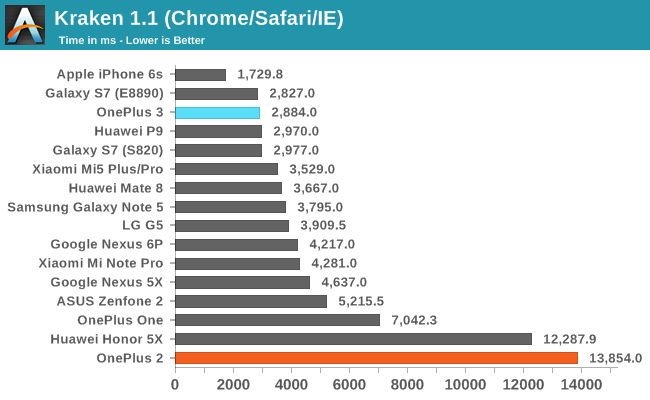
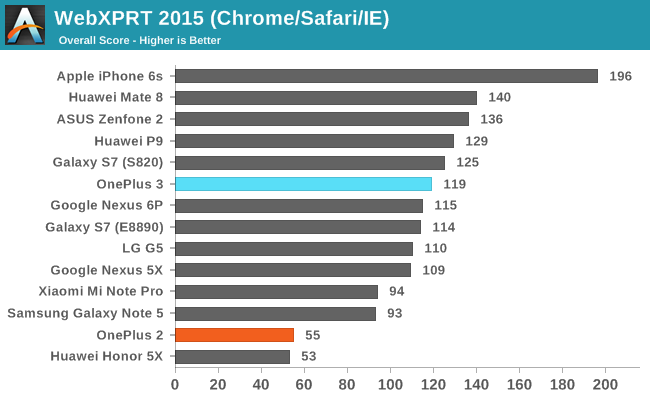
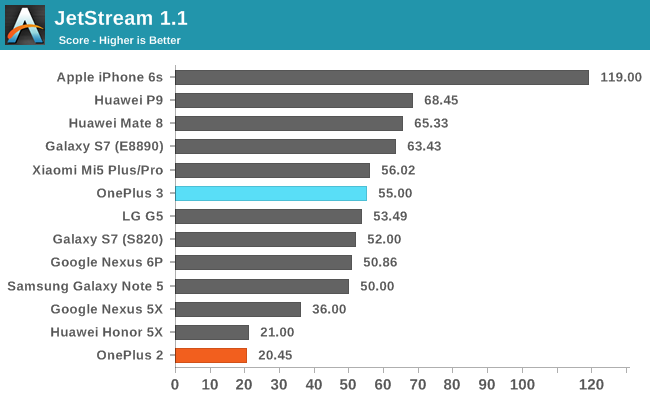
The improvement in web browsing performance when going from the OnePlus 2 to the OnePlus 3 is staggering. This isn't unexpected when you consider that the OnePlus 2 was just running on Cortex A53 cores that were meant for low power scenarios while the OnePlus 3 is using Qualcomm's Kryo cores. In Kraken the OnePlus 3 is over four times faster, while in WebXPRT and JetStream it's at least over two times faster. The OnePlus 2 actually represented a large regression in web performance compared to its predecessor, and OnePlus has brought web performance back to a level that is competitive with the other smartphones on the market with the OnePlus 3.

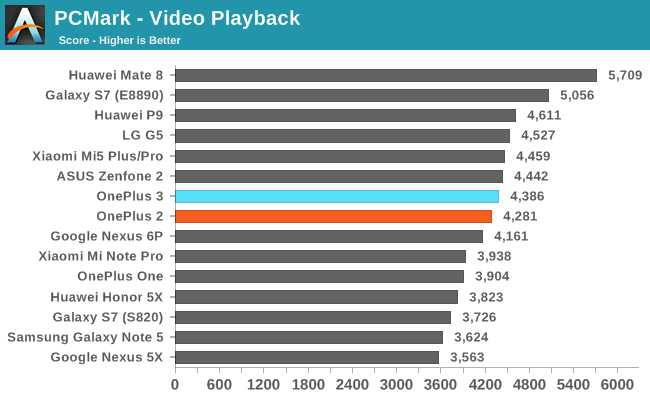

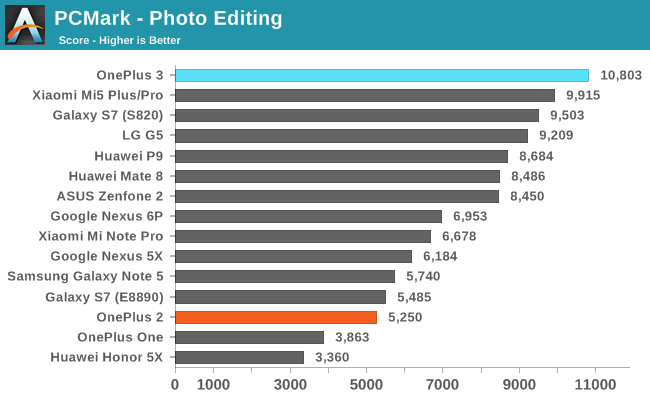
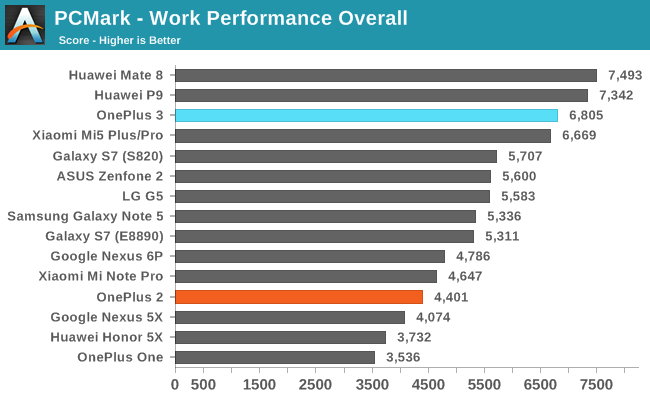
PCMark is an interesting test because it depends just as much on a phone's software as it does on the hardware. We've seen how devices with the same SoC can perform very differently, especially in certain sub-tests like the Writing and Photo Editing tests where different runtime and OS optimizations can have a large impact. The OnePlus 3 is no exception, with it achieving higher scores than the LG G5 in every test except for video playback where they have roughly the same scores.
This is not unexpected, as it was demonstrated in the LG G5 review that the G5 has more conservative frequency scaling than the other Snapdragon 820 devices that we've seen, which is reflected in PCMark's tests. In any case, the OnePlus 3 actually gets close to the Huawei Mate 8 in the writing test, and beats it and the LG G5 by a large margin in the photo editing test. In the end the OnePlus 3 places second on our overall chart, with only the Huawei Mate 8 ahead of it, and the gap between it and the Mate 8 being smaller than the gap between it and the Zenfone 2 which is the next fastest smartphone.
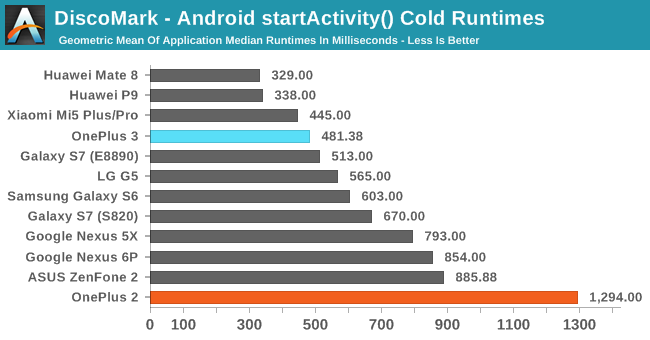
The OnePlus 3 is over two times faster than the OnePlus 2 with cold app launches where the application isn't resident in memory in any state. This is likely a combination of improved NAND performance, and changes to OnePlus's DVFS settings in addition to the performance improvements that Snapdragon 820 provides on its own. The impact that this has on the performance of the interface is significant, and when I reviewed the OnePlus 2 I noted how painfully slow it was to move around and through the applications. This new testing is a great example of that, with the OnePlus 2 taking 1.3 seconds just to launch apps, while the OnePlus 3 takes under 500ms and is the second fastest device here.
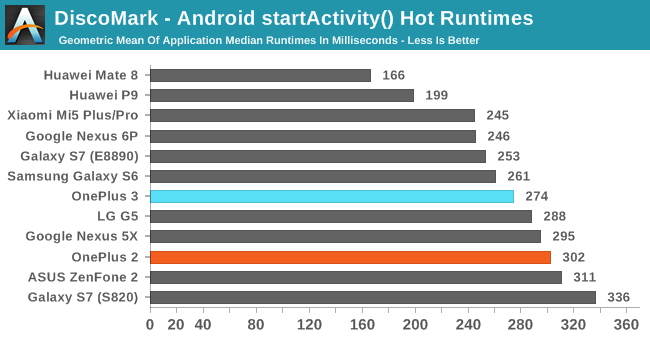
The OnePlus 3 improves a bit over the OnePlus 2 when resuming apps that are resident in memory, but not by a great deal. In general, all our devices hover between 250 and 300ms here, with the exception of the Huawei Mate 8 and P9 which are really in a category of their own for performance. While there's no enormous improvement here, the OnePlus 3 is competitive with other high end devices in the market, so there's nothing to complain about either.
One thing worth noting is that our set of apps wouldn't come close to utilizing the OnePlus 3's 6GB of RAM. Unfortunately, no matter how many apps we added, this would actually still be the case. The reason is that OnePlus has implemented very aggressive app eviction from memory, which means that your 6GB of RAM is really just sitting there using energy, and in general the utilization is pretty low. This may be a holdover from when the OnePlus 2 shipped in a 3GB configuration, but it's something OnePlus needs to address in a future OTA update. I'd imagine the Android enthusiast community is already at work on, or has already created custom kernels to alter this behavior as well. With 6GB of RAM you should be able to comfortably keep all of a user's frequently used apps resident in memory.
It's great to see that OnePlus is producing a smartphone with competitive performance once again. When the OnePlus One launched, Snapdragon 801 was the best you could get in an Android smartphone. The OnePlus 2 was an unfortunate victim of Snapdragon 810's heat and throttling problems, but OnePlus certainly didn't help the issue by hardcoding in mechanisms to detect Google Chrome and shut the A57 cluster off entirely. With the OnePlus 3 you get some of the best CPU performance in an Android phone, with PCMark's real-world tests demonstrating noticeable gains over the LG G5 which also uses Snapdragon 820. If I had to sum things up in a single line I'd just say that it's good to see that OnePlus is back in the game.


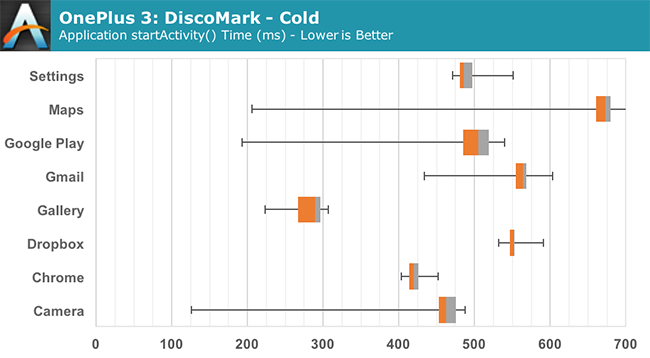
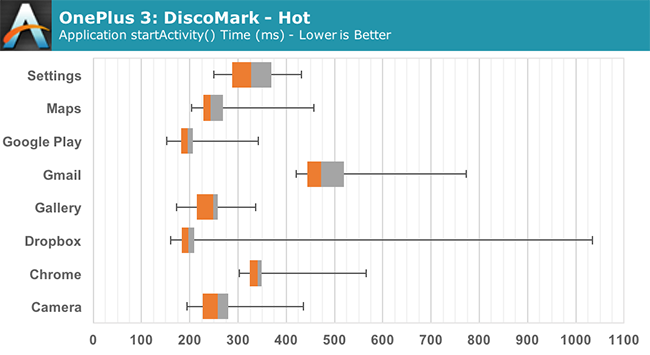








176 Comments
View All Comments
Andrei Frumusanu - Tuesday, June 21, 2016 - link
>> So you'll test if it's an Apple product using a standard created for projectors, OK. The Galaxy Tab S was touted as supporting the Adobe RGB standard- you didn't test that(either generation).iOS supports colour profiles. Android doesn't. Simple as that.
Matt Humrick - Tuesday, June 21, 2016 - link
sRGB is NOT our personal preference. We would love to see proper wide gamut support, and when a device supports a different gamut, we test it like we did for the iPad Pro 9.7". But until Android supports color management, testing against sRGB is the only thing that makes sense. A few other points:1) Most of the content you're going to view on a mobile device uses the sRGB color space, including web pages, games, and even the pictures and video taken with mobile devices.
2) Viewing a file intended for DCI on an iPad Pro 9.7" results in properly rendered colors, because iOS supports color management. Viewing the same file on an Android device with a wide-gamut panel results in innaccurate, oversaturated colors, because Android does not support color management and assumes everything is sRGB. Color space support requires both hardware and software support. The OP3, like almost every mobile device, lacks the software component.
3) Some people prefer these more vivid colors even if they do not match the content creator's intent. That's fine. We even help quantify how vivid the colors will look with our saturation test (each square represents a 20% increase in saturation up to 100% sRGB target), and a visual example with the color swatch.
zodiacfml - Tuesday, June 21, 2016 - link
Thanks to all Anandtech writers. I appreciate your replies in the comments.BenSkywalker - Tuesday, June 21, 2016 - link
I guess you just have a very unique perspective. From a professional perspective this doesn't make sense at all- ICC color profiles are simply one way to handle forced color accuracy, and not a terribly good one at that as GPU overrides of color balance are fairly normal anyway on most devices. From a consumer perspective wanting the least amount of colors possible doesn't make sense in any rational way that I can come up with. Apple's way of handling things gives you two calibration targets- one is the narrowest in use, the other designed for movie projectors. Force decode True Color is a pretty useful option when trying to maximize the range covered.
1)Most content isn't calibrated. Period. Content that has calibration as a very high priority, isn't calibrated using sRGB.
2)When moving from a wider gamut space to a narrower one you deal with truncation, where are you getting that it is going to go through multiple up and down scaled balances? That isn't how it works.
3)You say that's fine, and we see articles spending hundreds of words bashing displays if they don't do it under the most narrowly defined set of parameters imaginable.
BenSkywalker - Tuesday, June 21, 2016 - link
Side note- looking at your reported numbers, it appears they were shooting for Japan's NTSC standard as their white point is far closer to that then the US NTSC. I'm not sure where Japan is on your world map, mine obviously looks a little different :)
Oyeve - Tuesday, June 21, 2016 - link
Would be nice if you guys actually did a real S7 review so we could see a real comparison against this OP3. But no, we have skewed data that really is not relevant at all. Way to go guys!leopard_jumps - Tuesday, June 21, 2016 - link
Good job ! Yet something is missing : photos and videos in incandescent bulb light , are they yellowish .zodiacfml - Tuesday, June 21, 2016 - link
One question with camera testing. How come you still don't have a studio lab for camera testing? It can help uncover some design compromises. It may not have the value for a consumer purchase decision but it has entertainment value, at least for me.ElecDroid - Tuesday, June 21, 2016 - link
Thank you for the unbiased review💯 I was really thinking about buying this phone. The display is of the utmost importance to me. My 3 needs,wants or what have you when I'm shopping for a new smartphone follows. Display,chip performance,OS updates. If the display isn't top notch. I'm already turning the page. Which is why I have a Note 5. Just about all other sites are praising this phone. I can always trust Anandtech to do very thorough reviews! Thank You!aryonoco - Tuesday, June 21, 2016 - link
It would be really, really good if Anandtech could start listing the LTE bands that a device supports.The OnePlus 3 for example, has no SKUs which support all of Australian LTE bands, meaning that if you live in Australia, it will give you a very sub-optimal experience, irrespective of which carrier you use.
This is vital information for a smartphone user. It would be great if AT paid a little attention to this.